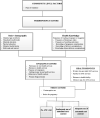Factors associated with inadequate receipt of components and non-use of antenatal care services in India: a regional analysis
- PMID: 36597104
- PMCID: PMC9808929
- DOI: 10.1186/s12889-022-14812-3
Factors associated with inadequate receipt of components and non-use of antenatal care services in India: a regional analysis
Abstract
Background: Failure to use antenatal care (ANC) and inadequate receipt of components of ANC pose a significant risk for the pregnant woman and the baby. This study aimed to examine a regional analysis of factors associated with receiving no ANC and inadequate receipt of components of ANC services among Indian women.
Method: Information from 173,970 women of reproductive age 15-49 years from the 2019-21 India National Family Health Survey (NFSH-5) was analysed. Logistic regression analyses that adjusted for cluster and survey weights were conducted to assess the socio-demographic and other factors associated with receiving non-use of ANC and inadequate receipt of components of ANC, respectively, in the six regions and 28 states, and 8 union territories in India.
Results: Across regions in India, 7% of women reported no ANC, and the prevalence of inadequate and adequate receipt of components of ANC in all six regions ranged from 67 to 89% and 8% to 24%, respectively. Of all the 36 federated entities, the prevalence of inadequate receipt of ANC components was less than two-thirds in Tamil Nadu, Puducherry, Andaman and the Nicobar Islands, Odisha, and Gujarat. Our analyses revealed that associated factors vary by region, state, and union territories. Women from poor households reported increased odds of receiving no ANC in North, East and North-eastern regions. Women who reported no schooling in South, East and Central regions were associated with increased odds of receiving no ANC. Women from poor households in Himachal Pradesh, Bihar, Uttar Pradesh, Nagaland, Manipur, Uttar Pradesh, and Madhya Pradesh states reported significantly higher odds of inadequate components ANC than women from rich households. The receipt of inadequate components of ANC was significantly higher among women who never read magazines in Delhi, Ladakh, Karnataka, Telangana, Jharkhand, Maharashtra, Uttar Pradesh, Chhattisgarh, Arunachal Pradesh, Manipur, and Mizoram states in India.
Conclusion: A better understanding of the factors associated with and incorporating them into the short- and long-term intervention strategies, including free financial support from the Indian government to encourage pregnant women from lower socioeconomic groups to use health services across all regions, states and union territories.
Keywords: Antenatal care; Demographic and health survey; India; Maternal health; Women.
© 2023. Crown.
Conflict of interest statement
The authors declare that they have no competing interests.
Figures
References
-
- Kassebaum NJ, Barber RM, Bhutta ZA, Dandona L, Gething PW, Hay SI, et al. Global, regional, and national levels of maternal mortality, 1990–2015: a systematic analysis for the Global Burden of Disease Study 2015. Lancet. 2016;388(10053):1775–1812. doi: 10.1016/S0140-6736(16)31470-2. - DOI - PMC - PubMed
-
- World Health Organization. World health statistics 2010 2010. Available from: https://apps.who.int/iris/handle/10665/44292. cited 2021 2/12/2021
-
- World Health Organization. WHO recommendations on antenatal care for a positive pregnancy experience 2016. Available from: https://www.who.int/publications/i/item/9789241549912. cited 2021 3/12/2021 - PubMed
-
- World Health Organization. Women and health : today’s evidence tomorrow’s agenda 2009. Available from: https://apps.who.int/iris/handle/10665/44168. cited 2021 2/12/2021
-
- World Health Organization. Maternal mortality 2021. Available from: https://www.who.int/news-room/fact-sheets/detail/maternal-mortality. cited 2021 2/12/2021
MeSH terms
LinkOut - more resources
Full Text Sources
Medical



